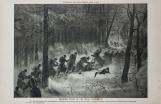1
PRE WWI PERIODOf the 1842 miles from Toronto to Qu'Appelle, only 72 miles of track remained unfinished, a distance that would have to be traversed on sleighs or on foot. On this night, members of the Toronto Grenadiers and Capt. Todd’s company of Ottawa Foot Guards, on their way to the North-West Rebellion, attempt to traverse the ‘gaps’ between Red Rock, Nipigon, and on to Port Arthur. The last 7 miles of these gaps would prove the toughest. On their dread mission, nature seems to ave confronted them with every obstacle that would inure them to hardship, and steel their hearts for the coming conflict.
Old campaigners were loud in their praise of the men: one man who had been in the Soudan affirmed that the march across the sands of the desert was not more trying than had been the tramp over the ice and snow of Superior. Sleet pelted them, and driving snow blinded their steps, while faces were blistered and eyes inflamed from the glare of the sun on the frozen surface of the lake. Not a few were badly frostbitten, and all were footsore and weary. What wonder that a few, becoming delirious on the march, dropped by the way from pain and exhaustion!
The needs of these men upon reaching Port Arthur represents the first involvement of the community in the medical service of the military. Thus begins the long and storied history of the military medical units of Northwestern Ontario.
2
Midnight Tramp of the Royal Grenadiers15 April 1885
Port Arthur, Ontario
 Credits:
Credits:Thunder Bay Miltiary Museum and History Society
3
The history of the Canadian Forces Medical Service (CFMS) coincides greatly with the history of Canada in general. Upon the establishment of the Dominion of Canada in 1867, development of its Militia and associated medical services became a top priority.In these early stages, the Canadian Militia medical services had no central organization. As a result each regiment recruited its own medical practitioners, often in the form of a unit surgeon or medical officer.
As Canada’s involvement in ‘Imperial defence’ increased, so too did the need for well-trained and organized medical personnel. The involvement of Canadian militia units in the Northwest Rebellion of 1885 and the overseas Boer War from 1899-1902 led to the creation of the Canadian Army Medical Corps (CAMC) in July 1904 to provide a unified command.
Two years later, in 1906, Colonel Eugene Fiset became Surgeon General and organized the fledgling CAMC into field-deployable units. That year, under General Order Number 5, 4 Field Ambulance was created on paper to oversee the militia medical services in Northwestern Ontario and the surrounding region.
4
Dr. G. Brown - Medical Officer for the Lake Superior Regiment1914
Port Arthur, Ontario
 Credits:
Credits:Thunder Bay Military Museum and History Society